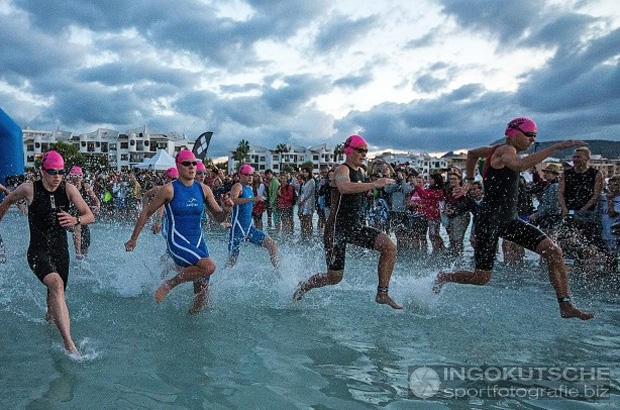
At 7am on Sunday the 23rd of September 2016, I competed in IronMan Mallorca. It was my 5th time toeing the start line of an iron-distance triathlon, which consists of a 2.4mile (3.8km) swim, 112mile (180km) cycle, then a 26.2mile (42.2km) run to finish it off.
I was doing this race to avenge a DNF (did not finish) result at IronMan Copenhagen 4 weeks previously. The DNF was caused by dehydration and having gone too hard in the early stages of the run leg triggering a heart arrhythmia where my heart rate reached 200 beats per minute, while I was walking! Fortunately, it returned to normal after about 30 minutes of lying on the ground with the paramedics keeping an eye on me but the race referee had arrived by this point and I was withdrawn from the race, just in-case it happened again. The most devastating part of this, aside from not being able to finish my main race of the year, was that I was only 10 kilometres from the finish line! In my previous experience, it’s the last 10km that does the most damage to you, and I woke up the next day not feeling too bad. After about 1 week of light training I realised that I definitely had another Ironman in me, and that I needed to do one before the end of the season as I had been holding back all year for Copenhagen and couldn’t bare to finish the year with no successes to my name.
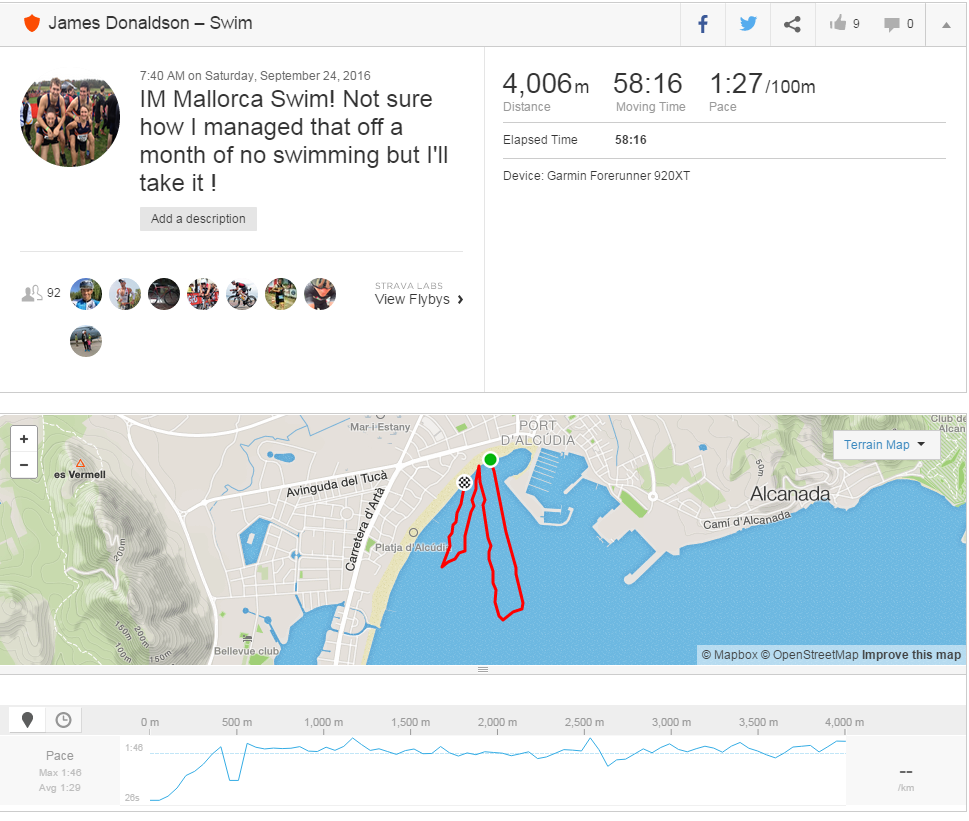 The Swim
The Swim
So, to the race! The swim took place in Alcudia beach – a lovely calm bay in the Northern part of the Island. The last 2 years have seen a new feature to the race start, the traditional mass-start has been exchanged for the new ‘rolling start’, wherein athletes seed themselves based on their predicted swim times and are sent off in groups of 6 at a time separated by 5 seconds. This makes for a much less violent swim, as you can imagine 3000 people all trying to be in the same place at once i.e. the shortest line around the course doesn’t make for a very civilised swim. I hadn’t 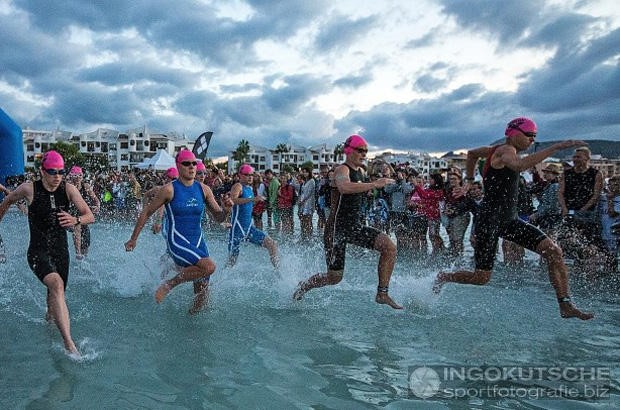 swum much between Copenhagen and Mallorca, but I did manage to get a couple of handicap 200-meter swim/run races in with my girlfriend while we were on holiday in France – more than enough training to tackle 3.8 kilometres in the sea! The swim at Mallorca is a special one due to the beautiful surroundings and the inclusion of an ‘Australian exit’ about 2.4km into the swim where athletes run along a short section of the beach before starting the second part of the swim. It turned out that I was very grateful for this short run after swimming in very salty water for about 35 minutes! I finished the swim
swum much between Copenhagen and Mallorca, but I did manage to get a couple of handicap 200-meter swim/run races in with my girlfriend while we were on holiday in France – more than enough training to tackle 3.8 kilometres in the sea! The swim at Mallorca is a special one due to the beautiful surroundings and the inclusion of an ‘Australian exit’ about 2.4km into the swim where athletes run along a short section of the beach before starting the second part of the swim. It turned out that I was very grateful for this short run after swimming in very salty water for about 35 minutes! I finished the swim 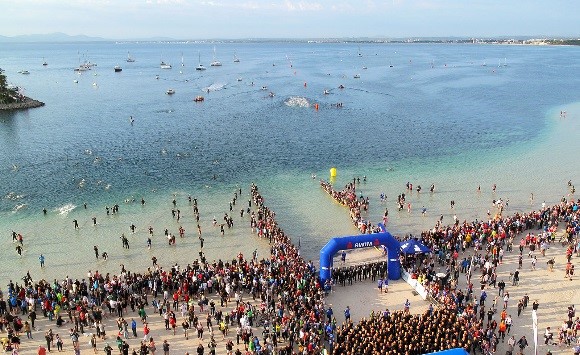 in 58 minutes 15 seconds, a good result for me considering my lack of swim training this year. There was
in 58 minutes 15 seconds, a good result for me considering my lack of swim training this year. There was
a short 400m run to the transition area where our bikes were located and I was shortly on my way along the flat main road out of Alcudia towards Can Picafort.
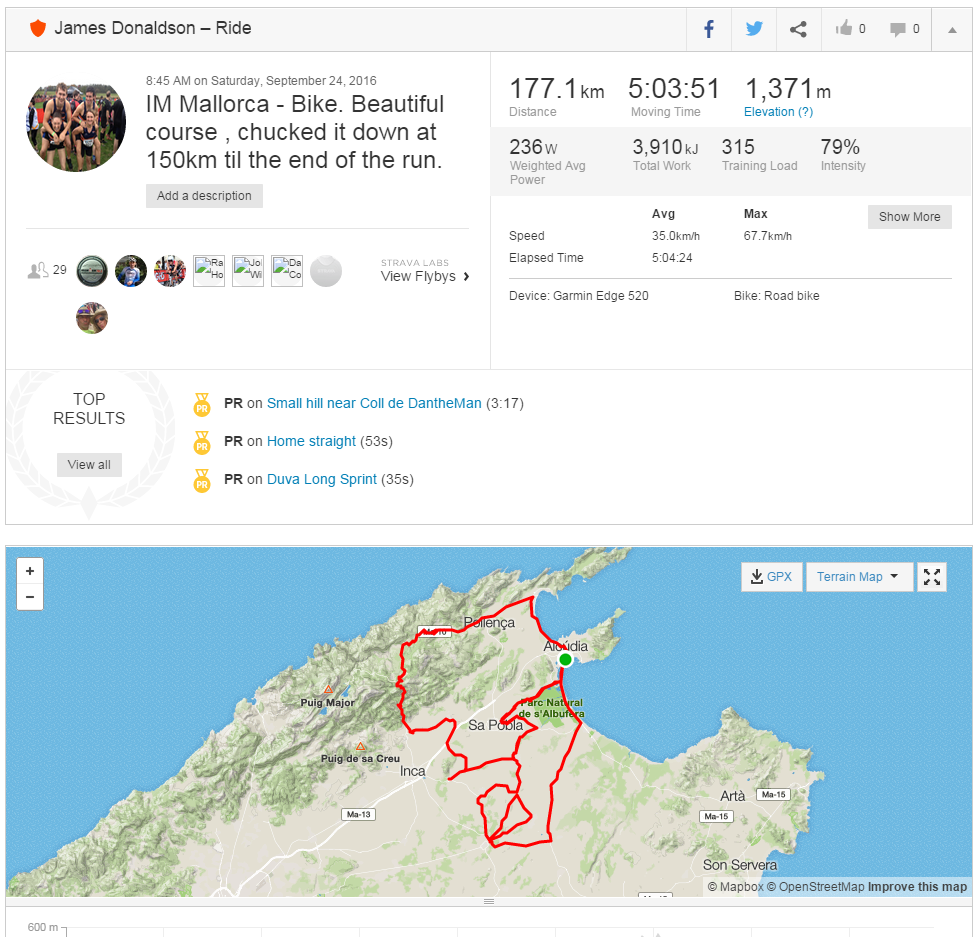 The Bike
The Bike
The bike is the longest section of the IronMan and was also the part that I’d been most worried about as there had been heavy thunder and lightning the day before the race. I knew that we were due a massive thunderstorm on the day of the race which would make the roads like glass, but by the time I had started the bike leg it was still dry. The first 110km of the bike are mostly undulating and take you through the small villages of the northern part of the island before climbing the Col de Femenia at 115km, which is a 12.5km mountain climb. I managed a good average speed during the initial flatter section, while being careful to avoid getting caught in the large groups of cyclists I passed, as triathlon is non-drafting during the bike leg. There came a point though where I reached an enormous group of ~100 riders. It took me about 10 minutes of riding above my target effort to get past them, and as soon as I got to the front the rider behind me simply latched onto my wheel, then overtook me 2 minutes later. While I was abiding by the rule of dropping back after being passed and leaving a 12-meter gap, people from the huge group decided to overtake me and fill in that, gap – pushing me back even further. While I sat at the back raging at the situation I realised that I could just sit about 20 meters back from the group and still get a slipstreaming benefit, I wouldn’t be going as fast as I wanted but I remembered that my friend, Tom, had impressed the importance of arriving at the bottom of the climb feeling fresh. Tom had learned this the hard way racing the previous year, as he was caught up in the effects of unleashing 300 similarly-fit triathletes upon a bike course at the same time, and was unable to ride up the climb as well as he could have done. With this in mind, I eased off the gas and decided to ‘make my move’ during the 5 kilometre run in to the bottom of the climb where the gradient slightly increased, enough to stretch out the peloton. Another rider and I made our move up the outside of the group, it wasn’t a huge effort as I didn’t go too far above my target average power output but I did want to hit the climb hard. When we hit the climb the rest of the group were caught and passed within the first 500 metres and I just tapped out a pace that I knew I could sustain to the top of the climb from my (many) sessions on the Wattbike at CCCU SportsLab, I 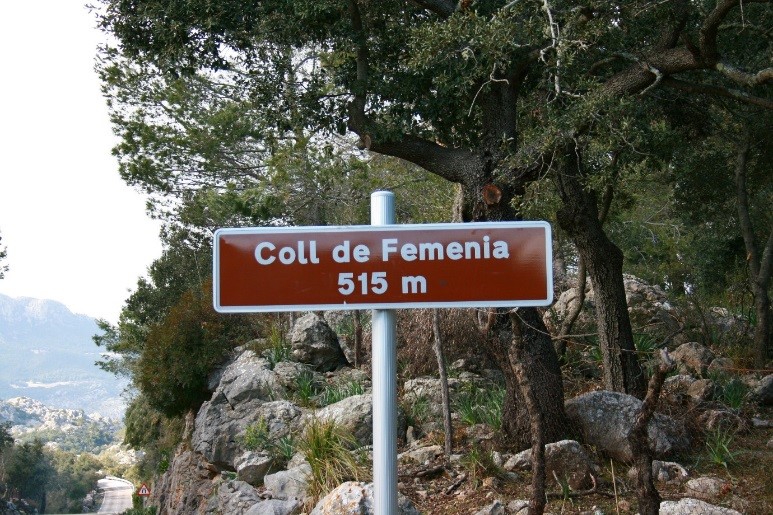 averaged about 290Watts for the climb. Thirty-five minutes of steady effort later I had made it to the top of the mountain and not been over taken once, while passing about 50 riders including a few female professionals. The most memorable moment of the climb for me was after reaching the summit, a young man crossed the road blowing an enormous cloud of smoke/vapour into my path. Not wanting to inhale whatever it was I swerved to the other side of the road to avoid it, his friend saw me move and immediately began to chastise the bloke in aggressive sounding Spanish, as I passed she gave me a thumbs up and ‘Vaya vaya’ while I laughed and gave my thanks. Following the climb was a glorious descent for 10km full of switch-backs down the other side of the mountain. The remainder of the ride was fairly uneventful until about 150 km, where the heavens opened and I found myself in the middle of monsoon season. To be honest, I was very lucky with the timing for this shower as a friend of mine, AJ, who was also doing the race got caught in the rain at the top of the climb, making for a very treacherous descent.
averaged about 290Watts for the climb. Thirty-five minutes of steady effort later I had made it to the top of the mountain and not been over taken once, while passing about 50 riders including a few female professionals. The most memorable moment of the climb for me was after reaching the summit, a young man crossed the road blowing an enormous cloud of smoke/vapour into my path. Not wanting to inhale whatever it was I swerved to the other side of the road to avoid it, his friend saw me move and immediately began to chastise the bloke in aggressive sounding Spanish, as I passed she gave me a thumbs up and ‘Vaya vaya’ while I laughed and gave my thanks. Following the climb was a glorious descent for 10km full of switch-backs down the other side of the mountain. The remainder of the ride was fairly uneventful until about 150 km, where the heavens opened and I found myself in the middle of monsoon season. To be honest, I was very lucky with the timing for this shower as a friend of mine, AJ, who was also doing the race got caught in the rain at the top of the climb, making for a very treacherous descent.
So, after 30km of wet, careful riding I returned to Alcudia for the second time to end the bike course in 5hrs 5 minutes. I had a bit of a kerfuffle in transition as thanks to missing the race briefing the day before, I had no clue were to chuck my run-kit bag once I’d removed the shoes and energy gels from it. Luckily an event volunteer was there to take the bag and tell me to get running; ‘¡Ánimo!’.
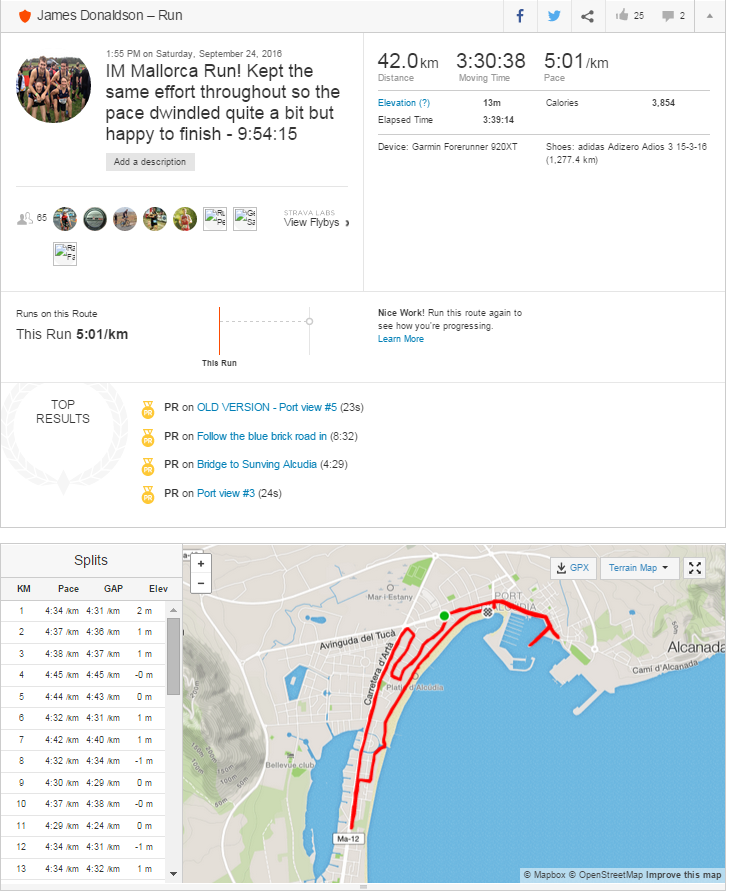 The Run
The Run
The run course involved 4 and a half times a lap of 9.5km along the high street, through some of the residential part of Alcudia, and then along the beach front before looping back onto the promenade and around to the high-street. Despite the pouring rain for the entire 3 and a half hours of my
run, the support from the locals, friends and family of other athletes, AJ’s partner, Josh, and random British holiday makers was immense and as encouraging as the crowds at the London Marathon. I started off at a steady pace and knew that all I wanted to do was survive the run and get a finish. My old nemesis, stomach troubles, started to give me issues after about 6km but I knew that it wouldn’t stop me from finishing (thankfully, there were toilets at every aid station, about 2km apart on the run!). When I came off the bike onto the run at Copenhagen I had less than 6 hours on the clock and potentially a Kona spot to chase down. I started off suicidally fast, running about 4:00minutes per km for the first 5km when my target was to hold 4:40 min/km. This is my usual tactic and I know that I will eventually settle to a maintainable pace, but combined with the 30-degree heat and necking 2-3 cups of Coke every 10 minutes, this lead to my DNF. My club mates and junior section coach, Bruno, had all given me a lot of advice on how to deal with this and my plan for Mallorca was to cap the first 5km of the run at 5:00min/km. I actually averaged this pace for the entire run so it definitely worked for me and next year my goal is to work on building pace throughout the IronMan marathon. I crossed the line after 9 hours 54 minutes of racing, which was good enough for 16th in my age-group out of ~180 and 175 overall out of 2500, including professionals. In terms of my goals for triathlon, I want to qualify for the world championships at Kona, Hawaii one day. I was about 30 minutes off the pace required to qualify at Mallorca, but considering my goal was just to finish, and having done nearly a full Ironman less than 4 weeks beforehand, I don’t think that it is too much of an unrealistic goal. My swim and bike are 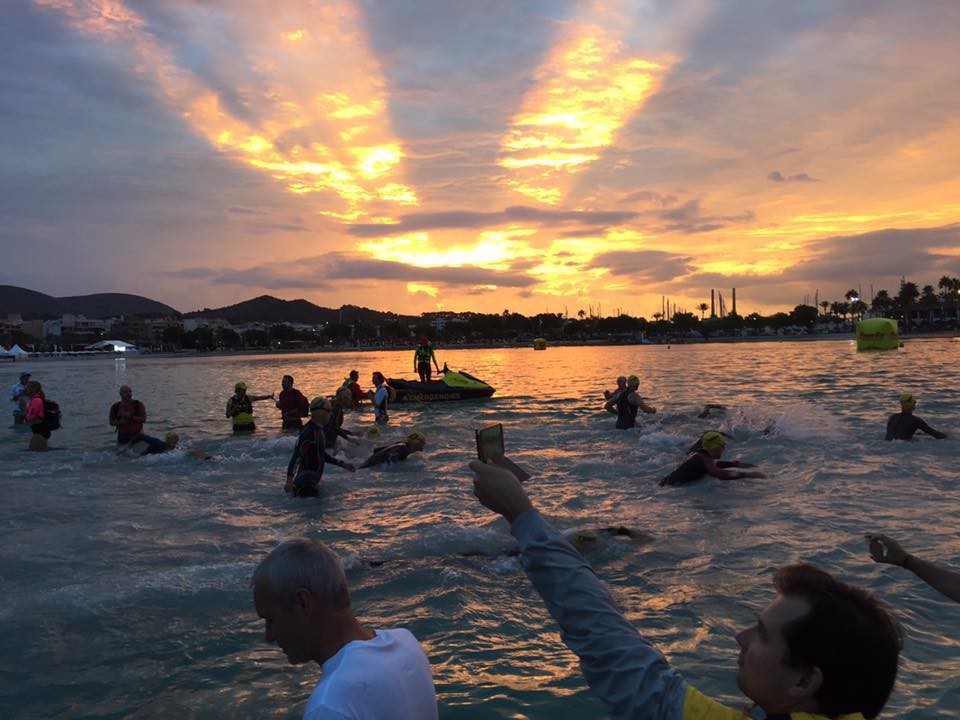 definitely up to the required level, as I was 11th in my age-group off the bike in Mallorca, but lost 5 places on the run (probably while in the loos!). Next year I hope to improve my run endurance off the bike and ability to maintain speed, which I can hopefully achieve through more specific training at SportsLab and with the advice from the experienced friends, club members and colleagues I’m lucky enough to know.
definitely up to the required level, as I was 11th in my age-group off the bike in Mallorca, but lost 5 places on the run (probably while in the loos!). Next year I hope to improve my run endurance off the bike and ability to maintain speed, which I can hopefully achieve through more specific training at SportsLab and with the advice from the experienced friends, club members and colleagues I’m lucky enough to know.
Thanks for reading! If anyone is interested in getting involved with triathlon please feel free to email me any questions @ james.donaldson@canterbury.ac.uk or on twitter @james_jogs.
 Christ Church Sport
Christ Church Sport James Cook
James Cook 803
803